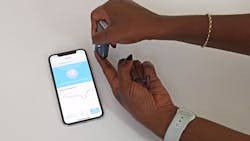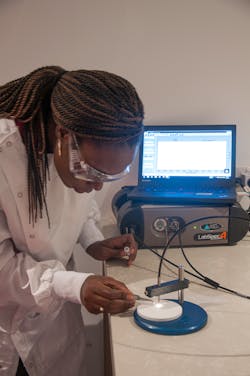Noninvasive technique hastens malaria detection
As the number of malaria cases rose to nearly 250 million worldwide in 2021, eradicating this life-threatening disease remains front-of-mind for medical researchers. It’s been complicated for decades, however, by those who are asymptomatic and unknowingly act as a reservoir for transmission of the disease by mosquitoes.
Today, researchers at the University of Queensland in Australia are progressing toward eliminating malaria, with the development of a light-based detector. Unlike conventional methods for malaria detection that require needles and chemical reagents to test blood, the new technology is noninvasive (see video).
“This tool addresses the challenge of needing to draw blood to test the presence of malaria particularly from those that do not have symptoms, as well as infants,” says lead researcher Maggy Lord, an Amplify Fellow in the School of Biological Sciences, and who also heads its Infrared Surveillance and Diagnostics group.
The technology is a handheld, smartphone-operated near-infrared diffuse reflectance spectrometer that operates in the 900–1700 nm wavelength range and features an indium gallium arsenide (InGaAs) detector. The team has used it in the past to detect and study infections in mosquitoes, but has shifted focus to human testing.
“It simply involves shining a harmless beam of light on a finger or ear lobe for less than 10 seconds, and results are instantaneous,” Lord says. This allows the researchers to collect an infrared signature that reflects what is present within a person’s blood stream.
“Malaria infects red blood cells, causing both structural and chemical changes,” Lord says. “These changes are observed in the reflected signature.”In collaboration with a team from the Instituto Oswaldo Cruz, a scientific institute in Brazil that focuses on biological sciences research and development of infectious and genetic diseases, the researchers tested the new spectrometer by scanning the right and left ears, arms, and fingers of 60 people in a malaria-endemic area in northern Brazil—some people had the disease, others didn’t. For this initial testing, blood was collected from the study participants to compare it—using microscopy and polymerase chain reaction (PCR) testing—with the spectra data collected via spectrometer scans.
The researchers note in their study—published in PNAS Nexus—that the data from infected patients was pooled regardless of which type of Plasmodium (malaria) parasite they were infected with, the body part scanned, or their level of parasitemia (the condition in which parasites are present within the blood; specifically, the presence of parasites without the person exhibiting clinical symptoms). This helped them to assess the capacity of their spectrometer to differentiate those carrying the disease from the uninfected subjects regardless of their parasitemia level.
With the data collected, the researchers used computer algorithms to develop predictive algorithms that can differentiate malaria-infected from uninfected people.
“The main reason we did this research is because of the presence of asymptomatic malaria patients that sustain malaria transmission,” Lord says. “These people do not have symptoms but can infect mosquitoes, which then infect other people. We wanted to develop a tool that is needle-free, rapid, and can scan thousands of people in a day; a tool that will make it easy for people to come forward to get tested for malaria.”
The team is now working to expand its proof-of-concept study to other malaria-endemic areas to ultimately develop more robust predictive models for malaria. The technique could prove especially effective in regions such as Africa, where the World Health Organization notes that four countries—Nigeria, the Democratic Republic of the Congo, United Republic of Tanzania, and Niger—accounted for a little over half of all malaria deaths worldwide in 2021.
“We hope that once fully validated,” Lord says, “our tool can be used for universal surveillance of malaria and guide current malaria elimination efforts set forth by the World Health Organization.”
About the Author
Justine Murphy
Multimedia Director, Digital Infrastructure
Justine Murphy is the multimedia director for Endeavor Business Media's Digital Infrastructure Group. She is a multiple award-winning writer and editor with more 20 years of experience in newspaper publishing as well as public relations, marketing, and communications. For nearly 10 years, she has covered all facets of the optics and photonics industry as an editor, writer, web news anchor, and podcast host for an internationally reaching magazine publishing company. Her work has earned accolades from the New England Press Association as well as the SIIA/Jesse H. Neal Awards. She received a B.A. from the Massachusetts College of Liberal Arts.


